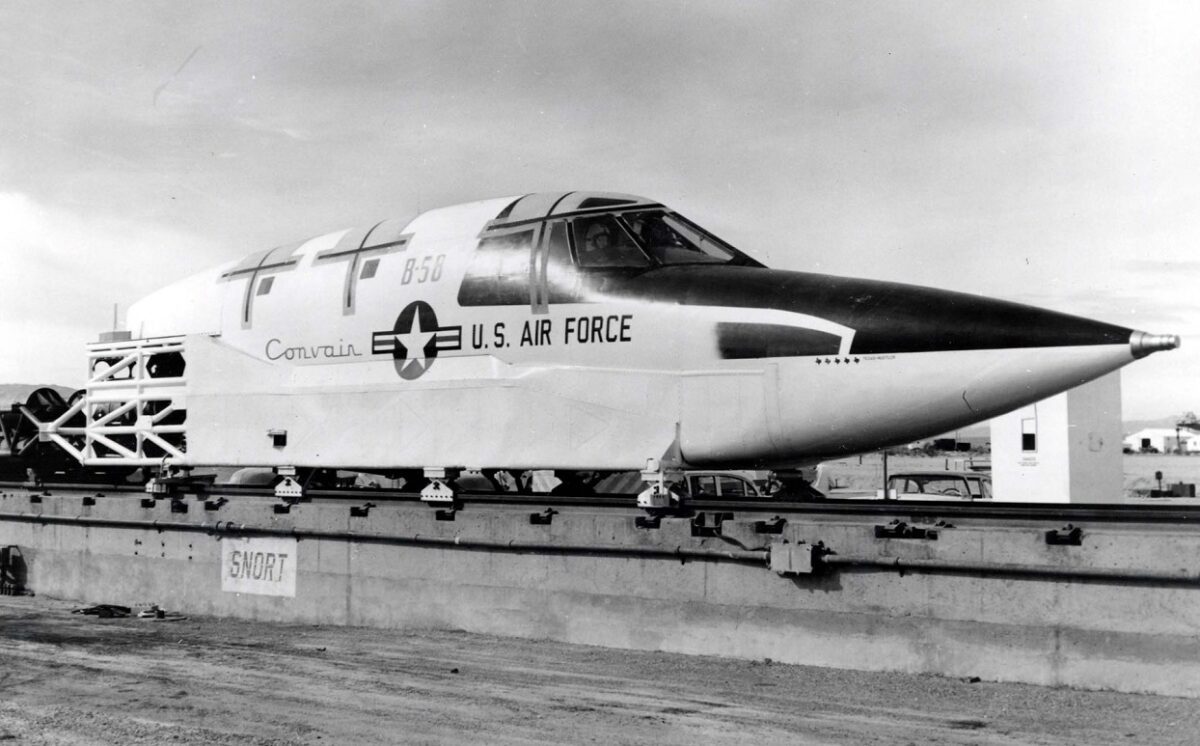The B-58 was not exactly a success in the eyes of the U.S. Air Force, as it never really was able to prove itself on the battlefields in the sky. But thank god for that, as this plane was designed to drop nuclear weapons on its enemies:
The United States has experience with supersonic jets, and that experience had to start with a first. It was the Convair B-58 Hustler that was America’s first supersonic jet bomber.

Hustling to Break the Sound Barrier
The B-58 Hustler made her maiden flight on Veteran’s Day of 1956 and officially entered into U.S. Air Force operational service on March 15, 1960. Planned as a replacement for the B-47 Stratojet — America’s first strategic jet bomber — she was built by the now-defunct Convair Division of General Dynamics, which also made the F-106 Delta Dart interceptor and the ginormous B-36 Peacemaker heavy bomber. As noted by the Federation of American Scientists (FAS) info page:

“The general operating requirement, SAB-51, called for the replacement of the B-47 to be the first supersonic bomber…The B-58 represented a drastic change from the B-47 in design, acquisition strategy, and deployment philosophy with SAB-51 being the first time that Air Force requirements called for radical, technological advances. The design specifications called for a Mach 2, high-altitude, medium-range nuclear bomber of minimum size to keep a low RCS [radar cross-section]…The B-58 had a delta wing design that included many firsts for strategic bombers. It had four turbojet engines with afterburners, and was the first supersonic aircraft with engine pods mounted outboard on the wings. The wings had a span of 56 feet, 10 inches and were swept 60; the length was 96 feet, 9 inches; the height at the tail was 29 feet, 11 inches; and the maximum takeoff gross weight was 160,000 pounds. The crew consisted of a pilot, navigator, and defensive systems operator seated in tandem. While a retrofit provided each crew member an individual ejection capsule for supersonic bailout, the cramped crew cockpit made long missions like airborne alert very exhausting for the crew.”

Regarding that ejection capsule, it was first live-tested on a two-year-old black bear named “Yogi.” Tragically, though Yogi survived the ejection, he was later euthanized, so that doctors could examine internal organs for signs of damage.
As for the speed, not only did the B-58 indeed break the sound barrier, but it was also the first operational Mach 2 bomber, with a max airspeed of 1,319 mph (2,122 kph/ 1,146 knots). In the process, the speedy warbird achieved 19 world speed and altitude records and won five different aviation trophies, namely the Bleriot Trophy, the Thompson Trophy, the Mackay Trophy, the Bendix Trophy, and the Harmon Trophy.
Moreover, the Hustler was the first aircraft made of stainless steel honeycomb sandwich material, and the first aircraft to have stellar-inertial navigation. Armament-wise, the B-58 didn’t have a bomb bay but could carry one nuclear weapon externally with the centerline fuel pod fitting over it; four weapons, whether nuclear or conventional, could be carried on external hard points if the fuel pod was eliminated.

Missing Out on Combat, But Hitting It Off in Hollywood
However, for all of the impressive capabilities that the Hustler held, she was also stymied by mechanical issues and changing capabilities of the adversary’s aerial defenses. As noted by David Cenciotti, former Italian Air Force officer and founder and editor of The Aviationist:
“The phaseout of the fleet was ordered at the end of 1965, when the Soviets introduced highly accurate surface-to-air missiles and it was felt that the Hustler’s high-altitude attack profile could no longer guarantee success against increasingly sophisticated Soviet air defenses. Moreover, the aircraft was substantially more expensive to operate than other bombers, such as the (almost immortal) Boeing B-52 Stratofortress, and also suffered from a high rate of accidental losses.”
Though the B-58 never saw combat, she did gain at least a wee bit of filmic fame, thanks to the 1964 nuclear war suspense thriller Fail-Safe — based on the novel by Eugene Burdock and Harvey Wheeler — starring Henry Fonda, Walter Matthau, Fritz Weaver, and Dan O’Herlihy (best known to Generation X movie audiences as The Old Man in the original RoboCop).
In Fail-Safe, the Hustler portrays the “Vindicator,” a fictitious bomber inadvertently tasked with dropping “The Bomb” on Moscow. Yes, there was an actual American warplane called the Vindicator, but it was an ill-fated WWII Navy dive bomber, not a Cold War USAF jet. In addition, the late great Jimmy Stewart — a real-life USAF Brigadier General in addition to all of his acting accolades — flew in the back seat of a Hustler in the Air Force documentary film Champion of Champions.

Convair B-58 Ejection Capsule 3/4 front view. Forward fuselage mock-up mounted on a 4.1 mile railroad test track in the Mojave Desert. The rocket powered sled was used to test high speed ejections before development of the capsule enclosure system. (U.S. Air Force photo)
Where Are They Now?
The last B-58 was retired in January 1970. Out of the original 116 B-58s built, eight of them survive today. Among them: Cowtown Hustler at the National Museum of the United States Air Force at Wright-Patterson AFB near Dayton, Ohio; Snoopy at the photo test range of Edwards AFB, California; and Greased Lightning at the Strategic Air Command & Aerospace Museum in Ashland, Nebraska.
Expert Biography: Christian D. Orr is a former Air Force officer, Federal law enforcement officer, and private military contractor (with assignments worked in Iraq, the United Arab Emirates, Kosovo, Japan, Germany, and the Pentagon). Chris holds a B.A. in International Relations from the University of Southern California (USC) and an M.A. in Intelligence Studies (concentration in Terrorism Studies) from American Military University (AMU). He has also been published in The Daily Torch and The Journal of Intelligence and Cyber Security. Last but not least, he is a Companion of the Order of the Naval Order of the United States (NOUS).







